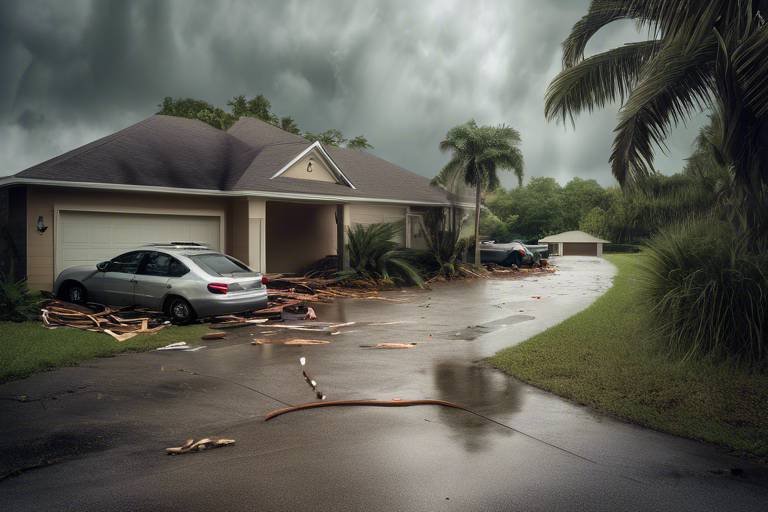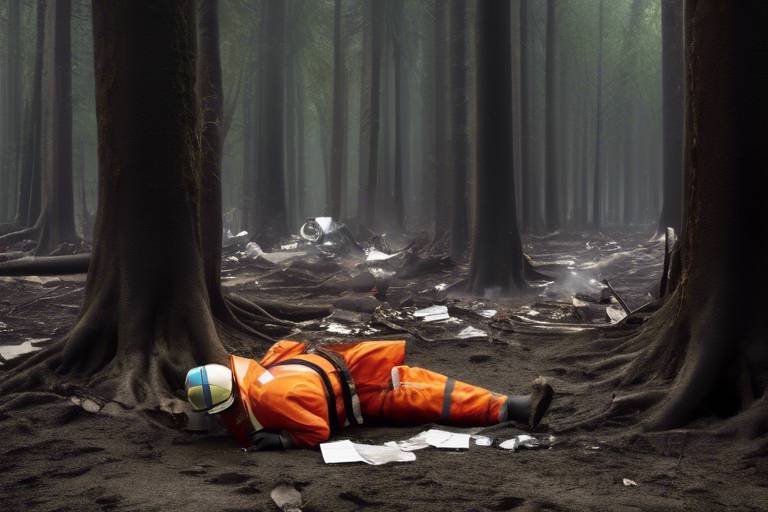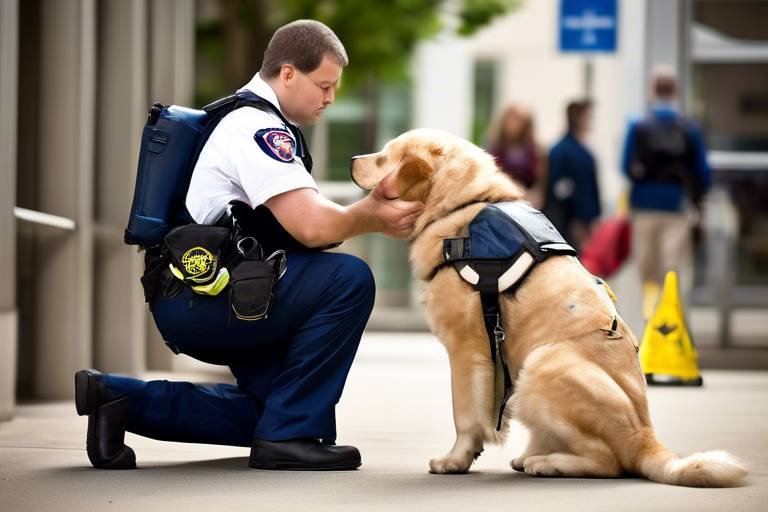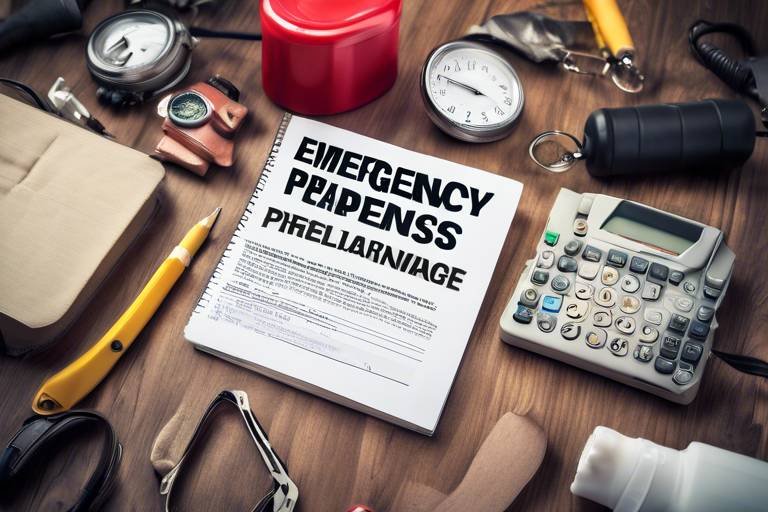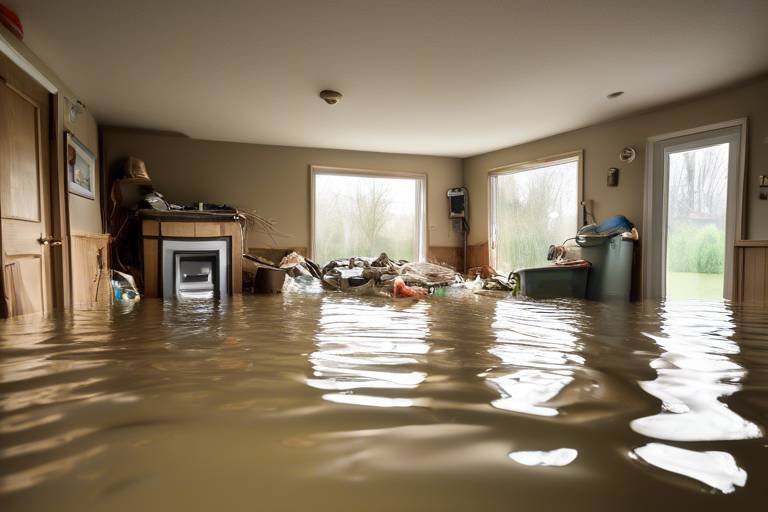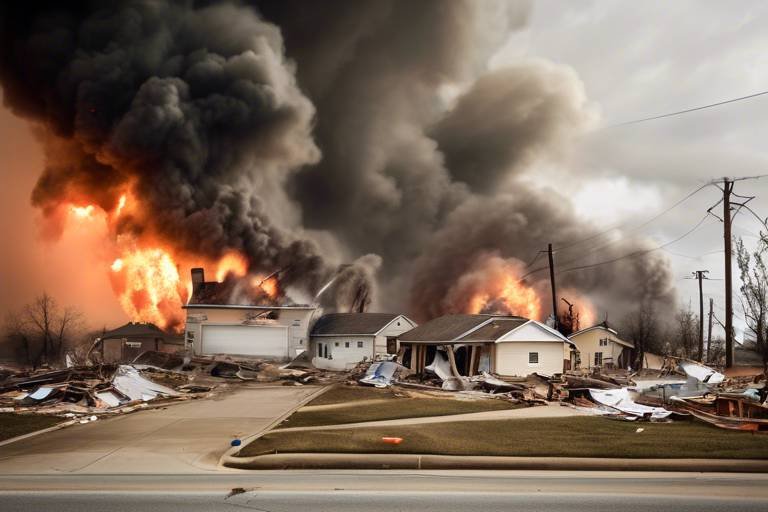Preparing Your Property for a Hurricane
Hurricanes can be both awe-inspiring and terrifying, can't they? With their swirling winds and torrential rains, they remind us of nature's raw power. As homeowners, it's our responsibility to safeguard our properties against the potential devastation these storms can bring. The key to effective hurricane preparedness lies in understanding the risks and taking proactive steps to minimize damage and ensure the safety of our loved ones.
First and foremost, it's essential to recognize that hurricanes are not just a seasonal inconvenience; they can cause significant destruction. By preparing your property, you not only protect your investment but also create a safe environment for your family. Imagine being able to weather the storm with peace of mind, knowing you've done everything possible to secure your home. This article will guide you through the necessary steps to prepare your property for a hurricane, from understanding hurricane categories to securing your home and creating an emergency plan.
As we dive deeper into this topic, we will explore the different categories of hurricanes, which range from Category 1, with winds of 74-95 mph, to the catastrophic Category 5, which boasts winds exceeding 157 mph. Each category presents unique challenges and risks, and knowing these can help you tailor your preparedness efforts accordingly. You wouldn't go into a battle without knowing your enemy, right? The same principle applies here.
So, what can you do to ensure your home is ready? It starts with creating a comprehensive emergency plan. This plan should include evacuation routes, local emergency services contact information, and communication strategies to keep in touch with family and friends during the storm. It's like having a map to navigate through a chaotic situation; it gives you direction when you need it most.
Another critical aspect of preparation involves securing your property. This means reinforcing windows and doors, managing your landscaping, and ensuring that your roof is in good condition. Think of your home as a fortress; the stronger the walls, the better you can withstand the storm. Additionally, having an emergency supplies checklist can make all the difference. Imagine needing supplies in the middle of a hurricane and realizing you forgot the essentials—it's a nightmare scenario that can easily be avoided.
Finally, we can't overlook the importance of insurance and documentation. Reviewing your insurance policy and keeping an inventory of your belongings can expedite the claims process after a disaster. It's like having a safety net; it may not prevent the fall, but it can help cushion the blow.
In the following sections, we'll delve into each of these topics in detail, providing you with the tools and knowledge necessary to prepare your property for a hurricane. Remember, preparation is not just about protecting your property; it's about safeguarding your peace of mind.
- What should I do if a hurricane is approaching?
Immediately check local weather updates, secure your property, gather emergency supplies, and follow your emergency plan.
- How can I reinforce my windows and doors?
Consider using storm shutters, plywood, or impact-resistant glass to protect against flying debris.
- What essential supplies should I have on hand?
Your emergency kit should include water, non-perishable food, medications, flashlights, batteries, and a first-aid kit.
- How can I stay informed during the storm?
Keep a battery-powered radio, and ensure your mobile devices are charged to receive alerts and updates.

Understanding Hurricane Categories
When it comes to hurricanes, understanding their categories is crucial for homeowners. Each category represents the storm's strength and potential impact on your property and safety. The Saffir-Simpson Hurricane Wind Scale classifies hurricanes into five categories based on their sustained wind speeds, which can help you gauge the level of preparedness needed. Let's break it down:
| Category | Wind Speed (mph) | Potential Damage |
|---|---|---|
| 1 | 74-95 | Very dangerous winds will produce some damage: well-constructed homes could see minor damage, while mobile homes could be severely damaged. |
| 2 | 96-110 | Extremely dangerous winds will cause extensive damage: major damage to roofs, siding, and some trees will be uprooted. |
| 3 | 111-129 | Devastating damage will occur: well-built homes may incur severe damage, and many trees will be uprooted or snapped. |
| 4 | 130-156 | Catastrophic damage: homes can suffer total roof failure, and most trees will be snapped or uprooted. |
| 5 | 157 or higher | Catastrophic damage will occur: a high percentage of framed homes will be destroyed, and total destruction of well-built houses is likely. |
Understanding these categories can help you make informed decisions. For instance, if a Category 3 hurricane is forecasted, you might want to evacuate early or take extra precautions to secure your home. The higher the category, the more severe the potential impacts. It's not just about the wind, though; hurricanes can also bring heavy rainfall, storm surges, and flooding, which can be just as damaging, if not more so.
Moreover, it's essential to stay updated on weather forecasts and warnings. The National Hurricane Center provides real-time updates that can help you track an approaching storm. If you know your area is prone to flooding, consider investing in flood insurance, which may not be covered under standard homeowner's policies. Remember, preparation is key, and understanding the categories is just the first step in safeguarding your home and loved ones.
In summary, being aware of hurricane categories can significantly influence your preparedness strategy. Whether you're securing your property or deciding whether to evacuate, this knowledge is your first line of defense against the unpredictable nature of hurricanes.
- What should I do if a hurricane is approaching? Stay tuned to local news and weather updates, secure your property, and follow your emergency plan.
- How can I find out the category of an approaching hurricane? Check reliable sources like the National Hurricane Center for updates and classifications.
- Is flood insurance necessary? If you live in a flood-prone area, it's highly recommended to have flood insurance, as it may not be covered by standard homeowner's insurance.

Creating an Emergency Plan
When it comes to hurricanes, having a solid emergency plan can be the difference between chaos and calm. Imagine this: the winds are howling, the rain is pounding, and you’re scrambling to figure out what to do next. Sounds stressful, right? By taking the time to create an emergency plan, you can ensure that you and your loved ones are prepared for whatever Mother Nature throws your way. This plan should encompass every aspect of your safety and well-being during a hurricane.
Your emergency plan should include a few key components that are crucial for keeping your family safe. First and foremost, you need to establish a communication strategy. This involves determining how you will stay in touch with family members and friends during the storm. Think about using group texts or social media to keep everyone updated on your situation. In the midst of chaos, having a reliable way to communicate is invaluable.
Next, consider where you will go if you need to evacuate. It’s essential to identify safe locations ahead of time, whether it's a friend’s house, a hotel, or a designated shelter. Knowing your evacuation routes can save you precious minutes when every second counts. You can even create a small map that outlines these routes, making it easy to grab and go when the time comes.
Additionally, don’t forget to include local emergency services in your plan. Familiarize yourself with their contact information and understand their roles during a hurricane. This knowledge can be a lifesaver, as these services are there to help you in times of need. Knowing how to reach them and what resources they provide can make a significant impact on your safety and peace of mind.
Lastly, maintaining an updated emergency supplies checklist is vital. You don’t want to find yourself in a situation where you’re missing essential items like water, food, or medical supplies. Here’s a quick checklist of items you should have ready:
- Water (one gallon per person per day for at least three days)
- Non-perishable food (at least a three-day supply)
- Flashlights and extra batteries
- First aid kit
- Whistle (to signal for help)
- Dust mask (to help filter contaminated air)
- Moist towelettes, garbage bags, and plastic ties (for personal sanitation)
- Manual can opener (for food if kit contains canned goods)
Creating an emergency plan is not just about preparing for the worst; it’s about empowering yourself and your family. By taking these proactive steps, you can face a hurricane with confidence instead of fear. So, gather your family, discuss your plan, and make sure everyone knows their role. Remember, a well-prepared household is a resilient household!
Q: How often should I review my emergency plan?
A: It’s a good practice to review your emergency plan at least once a year or whenever there are significant changes in your household, like moving or new family members.
Q: What should I do if I can’t evacuate?
A: If you can’t evacuate, find a safe room in your home, preferably on the lowest level and away from windows. Stock it with emergency supplies and stay there until help arrives.
Q: How can I keep my pets safe during a hurricane?
A: Include your pets in your emergency plan. Make sure you have supplies for them, such as food, water, and any medications they may need. Consider pet-friendly shelters if you need to evacuate.

Evacuation Routes
When a hurricane is on the horizon, every second counts, and having a clear understanding of your evacuation routes can be the difference between safety and chaos. Imagine being in the eye of the storm, and suddenly realizing that you don’t know where to go! It’s a terrifying thought, but with a little preparation, you can avoid that panic. Start by mapping out your local evacuation routes well before hurricane season hits. This isn’t just about knowing the roads; it’s about creating a mental map that you can rely on when the winds start to howl.
Begin by checking local government resources or websites that provide detailed maps of evacuation routes specific to your area. Many municipalities have designated paths that are designed to move residents away from danger quickly. Make sure to familiarize yourself with these routes, and if possible, drive them ahead of time. This practice run can help you identify potential hazards or bottlenecks and allow you to plan alternative routes. Remember, the goal is to **stay calm and collected** when it matters most.
Consider the following factors when planning your evacuation:
- Distance: Know how far you need to travel to reach safety. This will help you gauge how much time you’ll need.
- Traffic Patterns: During an evacuation, roads can become congested. Be aware of peak traffic times and try to leave early.
- Local Shelters: Identify nearby shelters or safe zones where you can head during an evacuation. Knowing where to go can give you peace of mind.
It’s also important to have a backup plan. In case your primary route is blocked or becomes unsafe, having a secondary route can save you precious minutes. Use apps or maps on your smartphone to keep updated on road conditions and closures as the storm approaches. And don’t forget to communicate your evacuation plan with family members. Make sure everyone knows the routes and the destination, so no one is left in the dark when it’s time to leave.
Lastly, make a habit of reviewing your evacuation plan regularly, especially as hurricane season approaches. Conditions can change, and so can the routes that are safe to take. By staying informed and prepared, you can ensure that when the time comes to evacuate, you’ll be ready to move swiftly and safely to your chosen destination.

Local Emergency Services
When a hurricane is looming on the horizon, understanding the role of can be a game-changer. These services are your first line of defense, ready to assist you in times of crisis. But how do you ensure you're making the most of their support? It starts with knowing who they are and what they can do for you.
Local emergency services typically include your fire department, police department, and emergency medical services (EMS). Each of these entities plays a vital role during a hurricane, from enforcing evacuations to providing medical assistance. It's crucial to familiarize yourself with their contact information and understand how they operate during emergencies. For instance, many police departments have dedicated units for disaster response, while fire departments often provide shelter and rescue services.
Moreover, you should consider establishing a relationship with these services before disaster strikes. Attend community meetings or emergency preparedness workshops they host. This not only helps you learn about their protocols but also allows you to ask questions and express any concerns you might have. Building this rapport can make a significant difference when you're in need of immediate assistance.
In addition, it's wise to stay informed about local emergency management plans. Many areas have dedicated websites or social media pages that provide real-time updates during a hurricane. These platforms often share crucial information such as:
- Evacuation orders
- Road closures
- Emergency shelter locations
- Resource availability
By keeping these channels open, you can stay ahead of the storm and make informed decisions. Remember, when the winds start howling and the rain begins to pour, the last thing you want is to be scrambling for information.
In conclusion, local emergency services are more than just responders; they are your partners in safety. By understanding their roles and establishing communication beforehand, you can navigate the storm with confidence. So, take a moment to reach out, ask questions, and prepare yourself for whatever Mother Nature throws your way.

Communication Strategies
When a hurricane strikes, maintaining communication with your loved ones can feel like trying to reach a distant star in a cloudy sky. It's crucial to have a solid plan in place to ensure that everyone stays informed and connected, even when the storm disrupts traditional communication methods. The key to effective communication lies in preparation and adaptability. Start by designating a family communication plan that outlines how each member will check in before, during, and after the storm. This plan should include contact information for family members, friends, and neighbors, as well as alternative ways to reach them if phone lines go down.
One effective approach is to establish a designated out-of-area contact. In the chaos of a hurricane, local phone lines may be overwhelmed or out of service. Having a friend or relative in a different state or region can provide a reliable point of contact. When the storm passes, family members can reach out to this person to let them know they are safe. This strategy not only alleviates stress but also helps keep everyone informed about each other's well-being.
In addition to traditional communication methods, consider utilizing technology to your advantage. Downloading communication apps that function over Wi-Fi can be a game-changer. Applications like WhatsApp, Signal, or Facebook Messenger can help you stay connected when cellular networks are down. Make sure everyone in your household is familiar with these apps and has them installed on their devices before the storm hits.
Another effective strategy is to use social media platforms to share updates. If you have access to the internet, posting on platforms like Twitter or Facebook can quickly inform a larger audience about your safety and situation. Just remember to keep your privacy settings in mind and share your location only with trusted contacts. In times of crisis, a simple status update can provide peace of mind to those worried about your safety.
Lastly, don’t underestimate the power of old-school communication. In the midst of a hurricane, a battery-powered radio can be a lifeline. It allows you to receive updates from local authorities and weather reports that can guide your next steps. Make sure to have extra batteries on hand and familiarize yourself with how to operate the radio before the storm hits. This simple tool can keep you informed and connected when other methods fail.
In summary, effective communication during a hurricane involves a blend of planning, technology, and traditional methods. By establishing a family communication plan, utilizing apps, engaging with social media, and keeping a battery-powered radio ready, you can ensure that you and your loved ones stay connected, no matter the circumstances. Remember, in times of crisis, staying informed is just as important as staying safe.
- What should I do if I can't reach my family during a hurricane?
Try contacting your designated out-of-area contact, who can relay messages between family members. - How can I ensure my phone stays charged during a hurricane?
Keep a portable charger handy and charge your phone before the storm hits. Also, consider investing in solar-powered chargers. - What if my internet goes out?
Have a battery-powered radio for updates and use offline messaging apps that allow communication over Wi-Fi.

Emergency Supplies Checklist
When it comes to hurricane preparedness, having the right supplies on hand can be the difference between chaos and calm. Imagine facing a storm with everything you need at your fingertips—sounds comforting, right? To help you achieve that peace of mind, here’s a comprehensive checklist of essential items you should gather before hurricane season hits. It's like packing for a long trip; you want to ensure you have everything you might need.
First and foremost, you’ll want to stock up on non-perishable food items. Think canned goods, dried fruits, and snacks that don’t require cooking. It’s essential to have enough food to last at least three days per person. In addition, don’t forget about water; aim for at least one gallon per person per day for at least three days. You can never have too much water during an emergency!
Next up, let’s talk about basic first aid supplies. A well-stocked first aid kit is crucial. It should include band-aids, antiseptic wipes, gauze, and any prescription medications you or your family members may need. You might even consider adding some over-the-counter medications like pain relievers and allergy meds. It’s like having your own mini pharmacy ready to go.
In addition to food and medical supplies, you’ll need to prepare for potential power outages. This means investing in a good flashlight and a supply of batteries. Candles can also provide light, but be cautious with them to avoid fire hazards. A battery-operated radio is another must-have, as it can keep you informed about weather updates even if the power goes out.
Let’s not forget about personal hygiene items. Stock up on toiletries such as soap, hand sanitizer, toothbrushes, and toilet paper. These might seem mundane, but trust me, you’ll be grateful for them when the storm passes and normal life resumes. Additionally, consider including pet supplies if you have furry friends; they’ll need food, water, and any medications as well.
To make this checklist even more digestible, here’s a quick overview of what you should gather:
| Category | Items |
|---|---|
| Food | Canned goods, dried fruits, energy bars |
| Water | One gallon per person per day for three days |
| First Aid | Band-aids, antiseptic wipes, prescription meds |
| Power Supplies | Flashlights, batteries, battery-operated radio |
| Hygiene | Soap, hand sanitizer, toilet paper |
| Pet Supplies | Food, water, medications |
Lastly, don’t forget to keep important documents safe and accessible. Store copies of your insurance policies, identification, and any other critical paperwork in a waterproof bag. This way, you can focus on staying safe rather than scrambling to find important items during the storm.
By preparing your emergency supplies checklist ahead of time, you’re not just getting ready for a hurricane; you're also ensuring that your family can weather the storm with as little stress as possible. Remember, preparation is key, and when you’re ready, you can face whatever nature throws your way!
Q: How long should my emergency supplies last?
A: Ideally, your supplies should last at least three days per person. However, having extra supplies on hand is always a good idea.
Q: What if I have pets?
A: Make sure to include pet food, water, and any necessary medications for your pets in your emergency supplies.
Q: Where should I store my emergency supplies?
A: Store your supplies in a cool, dry place that is easily accessible. Consider using waterproof containers to protect them from moisture.

Securing Your Property
When it comes to hurricane preparedness, is one of the most important steps you can take. Think of your home as your fortress; without strong walls and a solid defense, it stands vulnerable to the fierce winds and torrential rains that hurricanes can bring. So, how do you fortify your fortress? Let's dive into some practical steps that can help you protect your home and belongings from the wrath of nature.
First and foremost, consider the structural integrity of your home. This means checking the roof, walls, and foundation for any weaknesses. If your roof is old or damaged, it might be time for an upgrade. A sturdy roof can withstand the high winds associated with hurricanes, reducing the risk of leaks and further damage. Additionally, take a close look at your windows and doors; these are often the most vulnerable points of entry for water and wind. Reinforcing them can make a world of difference.
One effective method to secure your windows is to install hurricane shutters. These can be made from various materials, including plywood and metal, and offer robust protection against flying debris. If shutters aren't an option, consider using impact-resistant windows, which are designed to withstand hurricane conditions. Remember, it’s not just about preventing breakage; it’s about keeping water out, which can lead to extensive damage inside your home.
Now, let’s talk about doors. A solid door can be your first line of defense against strong winds. Ensure that your exterior doors are solid-core and equipped with deadbolt locks. For added security, you can reinforce the door frame with steel or a similar strong material. Additionally, using door braces can provide extra support during a storm, preventing the door from being blown in.
Next on the agenda is your yard. Landscaping plays a crucial role in minimizing hurricane damage. Trim any trees that are close to your house, as falling branches can cause significant harm. Additionally, consider removing any loose items from your yard that could become dangerous projectiles in high winds. This includes furniture, garden tools, and decorations. If you have large plants or trees, think about staking them or even removing them entirely if they pose a risk.
Lastly, don't forget about your garage and shed. Secure any items stored there, and if possible, park your car in a garage rather than outside. This simple act can prevent costly damage to your vehicle. Also, consider installing hurricane straps to secure your roof to the walls of your home. These straps help to hold your house together, preventing it from being lifted off the foundation during extreme winds.
In summary, securing your property is not a one-size-fits-all approach. Each home is unique, and the steps you take should reflect your specific circumstances. By reinforcing your windows and doors, managing your landscaping, and securing your garage, you can significantly reduce the risk of damage during a hurricane. Remember, preparation is key, and taking these proactive measures can make all the difference when a storm approaches.
- What is the best way to secure windows during a hurricane? Installing hurricane shutters or using plywood are effective methods for securing windows.
- How can I protect my roof from hurricane damage? Regular maintenance, such as replacing damaged shingles and installing hurricane straps, can help protect your roof.
- Should I remove outdoor furniture before a hurricane? Yes, removing or securing outdoor furniture can prevent it from becoming a projectile during high winds.

Windows and Doors Protection
When it comes to hurricane preparedness, protecting your windows and doors is one of the most critical steps you can take. These areas of your home are often the most vulnerable during a storm, and failure to secure them can lead to devastating water damage and structural issues. Imagine your home as a fortress; if the gates are weak, the entire structure is at risk. So, how do you fortify your fortress?
First and foremost, consider installing hurricane shutters. These can be made from various materials, including aluminum or polycarbonate, and they provide a robust barrier against flying debris and high winds. If shutters aren’t in your budget, plywood can be a cost-effective alternative. Just make sure to cut it to size and secure it tightly over your windows ahead of time. Remember, the goal is to prevent the winds from shattering your windows, which can lead to a domino effect of damage throughout your home.
Additionally, don't overlook your doors. A solid door can withstand a lot, but it’s essential to reinforce it further. Install deadbolt locks and consider using a door brace or a security bar. These measures can help keep your doors secure against the intense pressure that hurricanes can unleash. You might think of your door as the main entry point to your home; if it’s not sturdy, it’s like leaving the front door wide open for trouble!
Another effective method is to use impact-resistant glass for your windows. This type of glass is designed to withstand high winds and flying debris, significantly reducing the risk of breakage. If replacing your windows isn’t feasible, applying a protective film can also enhance their strength. This film acts as a shield, holding the glass together even if it does crack, much like a car windshield.
Lastly, don’t forget to regularly inspect and maintain your window and door seals. Over time, these can wear down, making it easier for water to seep in during a storm. A simple check-up can save you a world of trouble later on. Think of it as giving your home a health check-up before the storm season kicks in!
In summary, safeguarding your windows and doors is not just about adding layers of protection; it’s about ensuring your entire home remains intact during a hurricane. By taking these steps, you can significantly reduce the risk of damage and keep your family safe. Remember, preparation is your best defense!
- What materials are best for hurricane shutters? Aluminum and polycarbonate are popular choices due to their durability.
- How can I reinforce my doors? Install deadbolts and consider using a door brace or security bar for added strength.
- Is impact-resistant glass worth the investment? Yes, it can significantly reduce the risk of window breakage during a hurricane.
- How often should I check my window and door seals? It's a good idea to check them at least once a year, preferably before hurricane season.

Landscaping Considerations
When it comes to hurricane preparedness, landscaping might not be the first thing that comes to mind, but it plays a crucial role in safeguarding your property. Think of your yard as the first line of defense against the fierce winds and torrential rains that accompany hurricanes. By making smart landscaping choices, you can significantly reduce the risk of damage to your home and surroundings.
One of the most effective strategies is to focus on tree management. Large trees can be beautiful, but they also pose a risk during a hurricane. If you have trees that are close to your home, it's essential to assess their health. Dead or dying trees are more likely to fall during strong winds, so consider removing them before the storm season. Additionally, trimming branches that hang over your roof or power lines can prevent potential damage. Remember, it’s not just about the trees you have; it's also about the ones in your neighbor's yard that could become a projectile if the winds get high enough.
Another aspect to consider is your landscape design. Opt for plants that are more resilient to high winds. Native plants are often a great choice because they are adapted to your local climate and require less maintenance. Grouping plants together can also help create a windbreak, which can reduce wind speed and protect your home. Furthermore, consider using low-growing shrubs instead of tall ornamental grasses or trees that can catch the wind like a sail. This can significantly reduce the risk of uprooting or snapping during a storm.
Moreover, drainage is a crucial factor in landscaping that many homeowners overlook. Proper drainage can prevent flooding in your yard and around your home. Installing a rain garden or using permeable pavers in your driveway can help absorb excess water. If you have a slope in your yard, ensure that it directs water away from your home’s foundation. This can be as simple as reshaping the landscape to create a natural drainage path.
Finally, securing any loose items in your yard is vital. During a hurricane, even the smallest objects can become dangerous projectiles. Make sure to bring in or secure items like patio furniture, garden tools, and decorations. If you have any garden ornaments or statues, consider bringing them indoors or anchoring them down to prevent them from becoming hazards.
In summary, thoughtful landscaping can make a world of difference when it comes to hurricane preparedness. By managing trees, choosing resilient plants, ensuring proper drainage, and securing loose items, you can create a safer environment for your home and family. Remember, it’s all about reducing risks and being proactive. After all, a little effort now can save you a lot of heartache later!
- What types of plants are best for hurricane-prone areas?
Native plants and low-growing shrubs are typically more resilient to high winds and require less maintenance.
- How can I improve drainage in my yard?
Consider installing a rain garden, using permeable pavers, or reshaping your landscape to direct water away from your home.
- Should I remove my large trees before hurricane season?
It's wise to assess the health of your trees. If they are dead or dying, consider removal to prevent potential damage.
- What should I do with my outdoor furniture during a hurricane?
Bring in or secure all outdoor items to prevent them from becoming dangerous projectiles in strong winds.

Insurance and Documentation
When it comes to hurricane preparedness, are your safety nets. Think of them as the armor that protects you from the uncertainties of nature's wrath. Understanding your insurance coverage is crucial because it can mean the difference between financial recovery and devastating loss. As hurricane season approaches, take a moment to review your insurance policies. Are you adequately covered? Do you know what your policy includes and excludes? This is your opportunity to ensure that your home and belongings are protected against the potential devastation of a hurricane.
Start by contacting your insurance agent or company to discuss your current policy. Make sure to ask about the specific coverage for hurricanes, including wind and flood damage. Many homeowners assume their standard policy covers everything, but that’s often not the case. Flood damage, in particular, usually requires a separate policy. It’s essential to understand the exclusions and deductibles that may apply, as these can significantly impact your financial situation after a storm.
Another critical aspect of hurricane preparedness is keeping your documentation organized and accessible. Imagine facing a hurricane and then scrambling to find important papers in the chaos. You wouldn’t want to be looking for your insurance policy or property documents while the winds are howling outside. Instead, gather all necessary documents and create a secure, easily accessible location for them. This could be a waterproof container or a digital backup stored in the cloud.
Here’s a quick checklist of essential documents you should have ready:
- Homeowners or renters insurance policy
- Flood insurance policy
- Mortgage documents
- Identification (driver's license, passports)
- Medical records and prescriptions
- Inventory of your belongings (photos, receipts)
In addition to having these documents ready, it’s wise to create an inventory of your possessions. This can be as simple as taking photos of your home’s interior and exterior, along with a list of valuable items. In the event of a disaster, this inventory will not only help you file claims more efficiently but also ensure you receive the compensation you deserve for your losses.
Finally, don’t forget to inform your family members about where these documents are stored and how to access them. Communication is key, especially during emergencies. By ensuring everyone knows where to find important information, you can reduce stress and confusion if a hurricane strikes.
Q: What kind of insurance do I need for hurricane protection?
A: Homeowners should consider both homeowners insurance and a separate flood insurance policy, as standard homeowners insurance often does not cover flood damage.
Q: How often should I review my insurance policy?
A: It’s recommended to review your insurance policy annually or whenever you make significant changes to your property, such as renovations or major purchases.
Q: How can I document my property effectively?
A: Take detailed photos of each room in your home, including valuable items, and keep receipts for significant purchases. Store this information digitally and in a safe physical location.

Reviewing Your Insurance Policy
When it comes to hurricane preparedness, one of the most critical yet often overlooked steps is . Think of your insurance as a safety net that can catch you when the storm hits. But, just like a net, it needs to be in good condition and properly positioned to be effective. So, what should you focus on when diving into those policy documents? Let’s break it down.
First and foremost, you need to understand what your policy actually covers. Many homeowners assume that their standard home insurance will cover all types of damage caused by hurricanes. However, this isn't always the case. For instance, while wind damage is typically covered, flood damage often requires a separate flood insurance policy. This is crucial because flooding is one of the most common and devastating effects of hurricanes. If you live in a flood-prone area, you may want to consider getting additional coverage.
Next, take a good look at your deductibles. This is the amount you’ll need to pay out of pocket before your insurance kicks in. In many cases, hurricane-related damage may come with a higher deductible, so it’s essential to know what you’re getting into. If your deductible is too high, you might find yourself in a tough spot when you need to file a claim. It’s like having a great umbrella on a rainy day but realizing you forgot to check if it has any holes!
Don’t forget to document your property thoroughly. Creating an inventory of your belongings isn’t just a good idea; it’s a necessity. This documentation can be a lifesaver when it comes time to file a claim. You can create a simple list that includes:
- High-value items like electronics and jewelry
- Furniture and appliances
- Any renovations or improvements made to your home
In addition to a list, taking photos or videos of your property can provide visual proof of your possessions, which can speed up the claims process.
Lastly, don’t hesitate to reach out to your insurance agent or company for clarification. They can help you understand the nuances of your policy and suggest any necessary updates. Think of them as your personal hurricane preparedness coach, guiding you through the ins and outs of your coverage.
In summary, reviewing your insurance policy is not just a chore; it’s a crucial step in ensuring your peace of mind when hurricane season rolls around. By understanding what is covered, knowing your deductibles, documenting your property, and communicating with your insurance provider, you can fortify your financial protection against nature's fury.
- What should I include in my home inventory? Include high-value items, furniture, appliances, and any improvements made to your home.
- How often should I review my insurance policy? It's advisable to review your policy annually or after any significant life changes, such as renovations or acquiring new valuables.
- Is flood insurance necessary if I live in a low-risk area? Even in low-risk areas, flooding can occur unexpectedly. It's worth considering flood insurance for added protection.

Documenting Your Property
When it comes to hurricane preparedness, one of the most crucial steps you can take is . Imagine this: a storm hits, and when the dust settles, you’re left with the daunting task of remembering every single item you own. Sounds overwhelming, right? That’s why creating a detailed inventory of your belongings is not just a good idea; it’s essential. This documentation can expedite insurance claims and help you recover faster after a disaster.
Start by walking through each room in your home, taking the time to note down everything from furniture and appliances to personal items and collectibles. Use your smartphone or a camera to take photos or videos of each room. This visual evidence can be invaluable when dealing with insurance companies. Make sure to capture serial numbers and purchase dates for high-value items. It’s like giving yourself a digital safety net; the more thorough you are, the easier it will be to prove ownership later.
Don’t forget to include outdoor items too! Your patio furniture, garden tools, and any other possessions outside your home should be documented as well. They might not seem as important, but they can add up in value and should be accounted for in your inventory. Consider creating a property documentation table to keep everything organized. Here’s a simple structure you can use:
| Item Description | Location | Value | Purchase Date | Serial Number |
|---|---|---|---|---|
| Living Room Sofa | Living Room | $800 | March 2020 | 123456789 |
| Refrigerator | Kitchen | $1200 | January 2019 | 987654321 |
| Garden Tools | Garage | $150 | June 2021 | N/A |
Once you’ve completed your inventory, store copies in multiple safe locations. Consider keeping a digital copy in the cloud, so you can access it from anywhere, even if your physical copies are damaged. You might also want to share this information with a trusted friend or family member. This way, if anything happens, they can help you with the process.
Lastly, remember that documenting your property isn’t a one-time task. Make it a habit to update your inventory regularly, especially after significant purchases or changes in your home. Think of it as a living document that evolves with you and your belongings. By taking these steps, you’ll not only protect your assets but also gain peace of mind knowing you’re prepared for whatever comes your way.
- Why is documenting my property important? Documenting your property helps streamline the insurance claims process and ensures you have proof of ownership for your belongings.
- What should I include in my property inventory? Include all significant items such as furniture, appliances, electronics, and outdoor equipment. Don’t forget to note down their value and any identifying details like serial numbers.
- How often should I update my inventory? It’s a good practice to update your inventory whenever you make significant purchases or changes in your home.
- Where should I store my documentation? Keep copies in multiple safe places, including a digital copy in the cloud and a physical copy in a safe or with a trusted person.
Frequently Asked Questions
- What should I do to prepare my property for a hurricane?
Preparing your property involves several key steps, such as reinforcing windows and doors, securing outdoor furniture, and ensuring your roof is in good condition. It's also essential to create an emergency plan and gather necessary supplies ahead of time.
- How can I understand the different categories of hurricanes?
Hurricanes are categorized from 1 to 5 based on their wind speeds and potential damage. Understanding these categories helps you assess the risks and prepare accordingly. For instance, a Category 1 hurricane has winds of 74-95 mph, while a Category 5 can exceed 157 mph, causing catastrophic damage.
- What should be included in my emergency plan?
Your emergency plan should include evacuation routes, communication strategies, and a list of local emergency services. It’s crucial to discuss this plan with your family so everyone knows what to do when a hurricane threatens your area.
- How do I secure my windows and doors?
There are several methods to secure windows and doors, such as installing storm shutters, using plywood boards, or applying impact-resistant films. These measures can significantly reduce the risk of breakage and water intrusion during a storm.
- What items should I have in my emergency supplies kit?
Your emergency supplies kit should include essentials like water, non-perishable food, a flashlight, batteries, a first-aid kit, medications, and important documents. Having these items ready can make a huge difference in your safety and comfort during a hurricane.
- How can I document my property effectively?
To document your property, create a detailed inventory of your belongings, including photos and receipts. This documentation will be invaluable when filing insurance claims after a hurricane, ensuring you receive the compensation you deserve.
- Why is it important to review my insurance policy before hurricane season?
Reviewing your insurance policy ensures that you have adequate coverage for hurricane-related damages. It's essential to understand what is covered and what isn’t, so you can make any necessary adjustments before the storm season hits.

